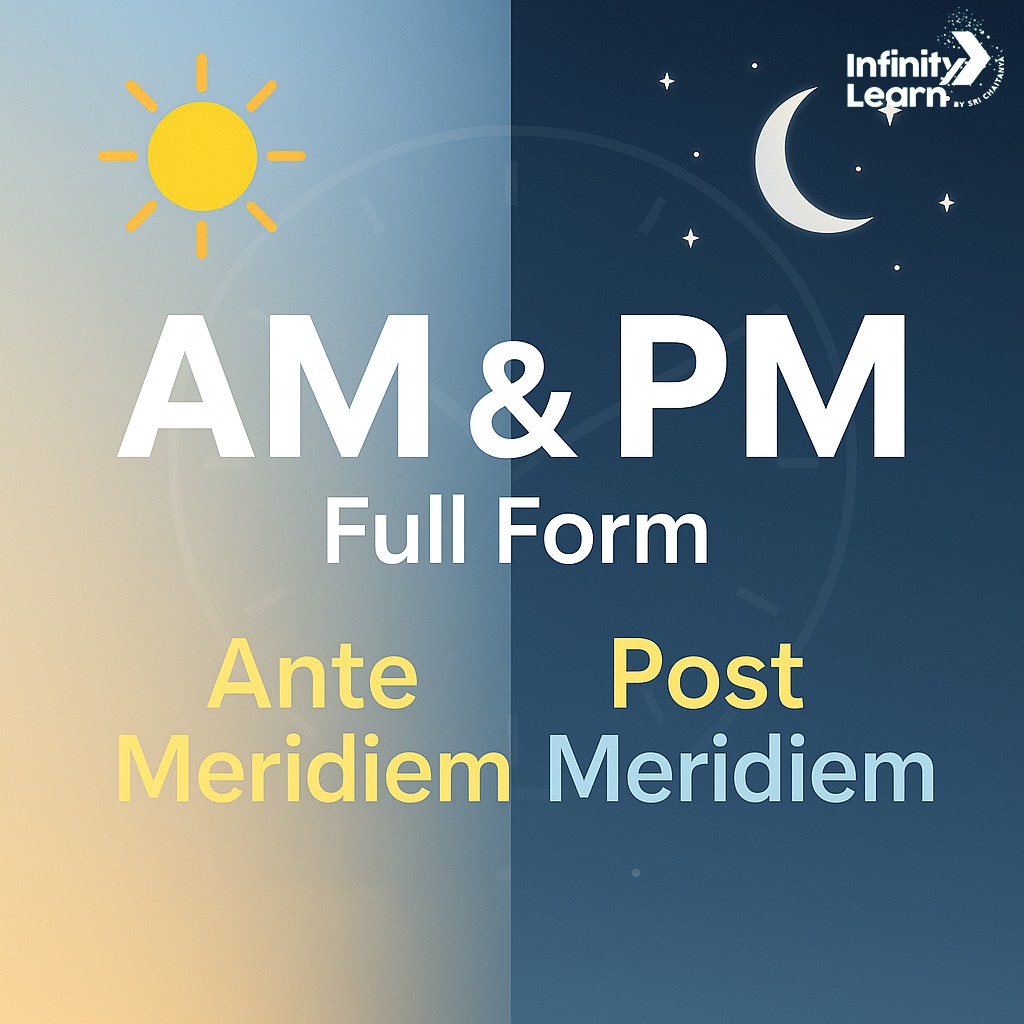Table of Contents
Full Form of AM and PM: Time is an important factor in our lives, and the 12-hour clock system is based on two groups of 12s to describe a 24-hour day using AM and PM. AM and PM are derived from Latin: Ante Meridiem (before noon) and Post Meridiem (after noon), also known as am/pm.
Every day is divided into 24 hours, 60 minutes in each hour, and 60 seconds p/m. But when telling time, we often use a 12-hour clock with labels A.M and P.M. Understanding what these abbreviations mean, how they work, and how to convert between 12‑hour and 24‑hour formats is essential.

This article covers the A.M and P.M. full forms, usage, conversion, history, nuances, and common confusions, perfect for learners or reference.
Full Form of AM
A.M. is derived from the Latin phrase ante meridiem, which means “before midday.” In other words, any time from midnight (00:00) to just before noon (11:59) falls in the ante meridiem part of the day. That means:
- 12:00 A.M. — Midnight (the start of a new day)
- 3:00 A.M. — Deepest part of the night
- 8:30 A.M. — Morning, likely breakfast or rush hour
- 11:45 A.M. — Almost lunchtime!
So if your alarm goes off at 6:00 A.M., you know it’s early morning, not evening.
Do Check: AICTE Full Form
Full Form of PM
P.M. is an abbreviation of post meridiem, which is Latin for “after midday.” Hence, any time after precisely 12:00 noon before midnight (11:59 P.M.) is P.M.
- 12:00 P.M. — Noon (lunchtime!)
- 3:30 P.M. — Early afternoon, if it happens between your late morning cup of coffee and your 4 p.m. cup of coffee
- 7:00 pm — Evening, likely time for dinner
- 11:00 P.M. — Late primetime
If someone says, “Let’s meet at 8 P.M.,” you know they mean evening, not morning.
AM and PM Full Form in Hindi
समय हमारे जीवन में एक महत्वपूर्ण कारक है, और 12 घंटे की घड़ी प्रणाली 12 के दो समूहों पर आधारित है जो AM और PM का उपयोग करके 24 घंटे के दिन का वर्णन करती है।
AM और PM लैटिन से निकले हैं: Ante Meridiem (दोपहर से पहले) और Post Meridiem (दोपहर के बाद), जिन्हें am/pm के रूप में भी जाना जाता है।
Do Check: ADB Full Form
Historical Origins of AM and PM
- The ancient Egyptians and Mesopotamians developed early timekeeping systems, dividing daytime and nighttime into 12‑hour intervals.
- During Roman times, people used the term meridiem (midday) to denote the sun’s passing through the meridian, and the words Ante (before) and Post (after) were appended to create AM and PM.
- This system, dividing the day into two halves, became established in analog clocks and written timekeeping.
Why Do We Use A.M and P.M.?
The 12‑hour clock system with A.M. and P.M. is deeply rooted in history. Long before clocks were digital, people divided the day into two 12‑hour periods based on the sun’s position. This made sense:
- The hands of traditional clocks only go around once every 12 hours.
- Dividing the day at noon (midday) or midnight offered a clear way to distinguish morning from afternoon, evening, and night.
- When mechanical clocks were invented, Latin was the language of scholars and the church in Europe, so terms such as ante meridiem and post meridiem became standard.
The 12‑hour clock system is still widely used today in countries like the United States (US), Canada, Australia, and the Philippines. It is favored for its familiarity, especially in everyday, non-scientific contexts.
Do Check: ACC Full Form
How to Use A.M. and P.M. Correctly?
Whether you’re writing an email, creating a schedule, or planning a meeting, using A.M. and P.M. correctly is essential for clarity and professionalism.
These abbreviations are not just about telling time; they follow specific punctuation and formatting rules that vary across style guides.
Writing Conventions
- With periods: Many style guides prefer A.M. and P.M. with periods after each letter.
- Without periods: It’s also common to write them as A.M and P.M.
- Spacing: You can write “8 A.M.” or “8 A.M.”, but be consistent in punctuation and formatting.
Noon and Midnight Confusion
- 12:00 A.M. = Midnight: By convention, 12:00 A.M. represents the very start of a new day.
- 12:00 P.M. = Noon: 12:00 P.M. is when the sun is typically highest in the sky—midday.
Spoken Use
When speaking, people often say:
- “Eight A.M.” rather than “Eight ante meridiem,” because the full Latin phrase is considered overly formal or archaic in daily conversation.
- They say “twelve noon” or just “noon” instead of “twelve P.M.” if they want to avoid confusion.
Do Check: ABG Full Form
Converting AM and PM to 24‑Hour Clock
Many countries and military applications use the 24‑hour clock, also known as military time, which runs straight from 00:00 to 23:59. Here are quick conversion steps:
| 12‑Hour Time | 24‑Hour Equivalent |
| 12:00 A.M. (midnight) | 12 – 12 = 00:00 |
| 12.30 | 12:30 – 12 = 00:30 |
| 1:00 P.M. to 11:59 P.M. | 13:00 to 23:59 |
How to convert from 12‑hour to 24‑hour
- If it’s A.M. and the hour is 12, use 00 (example: 12:30 A.M. — 00:30).
- If it’s A.M. and the hour is 1–11, it remains the same (example: 7:45 A.M. — 07:45).
- If it’s P.M. and the hour is 12, keep it as 12 (example: 12:20 P.M. — 12:20).
- If it’s P.M. and the hour is 1–11, add 12 (example: 2:15 P.M. — 14:15).
Global Usage of AM and PM
- United States & Canada: The 12‑hour clock with A.M. and P.M. is dominant for daily life—on schedules, computers, phones, benches, televisions.
- Europe, Asia, Latin America, Africa: Many countries use the 24‑hour clock in official settings like transportation schedules, military matters, and medical institutions.
- Countries may adopt a mix. For instance:
- In India and the UK, television or radio may use the 12‑hour system, while train schedules use the 24‑hour style.
- Many countries permit both in informal use, but official signage and timetables typically use the 24-hour clock.
Common Misconceptions About AM and PM
Mixing “Noon” and “12 P.M.”
- Some people think “12:00 P.M.” is midnight. Remember:
- 12:00 P.M. = Noon, when the sun is highest.
- Yellow rule: If in doubt, just say “noon” or “midnight.”
Forgetting the Appropriate A.M./P.M. Label
Simply writing “7:00” is ambiguous, especially internationally. Always clarify:
- “7:00 A.M.” (early morning)
- “7:00 P.M.” (early evening)
Using “24‑Hour” Labels Without Clarity
If someone sends “18:45”, that’s typically understood as “6:45 P.M.” But in casual conversation, saying “6:45” with no marker might be unclear—again, context matters.
Do Check: AAI Full Form
A.M. and P.M. in Digital vs. Analog Clocks
- Analog clocks have hour hands and typically no explicit AM/PM labels—context tells you whether it’s morning or evening.
- Digital clocks and devices often show “10:05” and let you set a prefix of AM or PM, or toggle a 24‑hour mode.
Why do AM and PM Matter Today?
Although we don’t tend to say “ante meridiem” or “post meridiem” out loud, it’s still helpful to know what they mean. Here’s why:
- No More Confusion – Example: Have You Wondered Whether That 12:00 is at Noon or Midnight? These labels keep things straight, especially when it comes to those confusingly timed midnights and noons.
- Precision Counts – Be it legal papers, medical timetables, flight times, or international business, there’s no place for error. AM/PM helps to make sure everyone’s on the same page.
- We use AM & PM without thought everyday, from setting morning alarms to planning evening events, and do it without even thinking twice.
- Digital literacy: Computers, schedules, and digital platforms often rely on 24-hour formatting.
FAQs on AM and PM Full Form
What is the full form of A.M. and P.M.?
A.M. stands for Ante Meridiem, meaning 'before midday,' and P.M. stands for Post Meridiem, meaning 'after midday.'
Is 12:00 A.M. midnight or noon?
12:00 A.M. is midnight, the start of a new day. 12:00 P.M. is noon.
How do I convert 2:30 P.M. to 24-hour format?
To convert 2:30 P.M. to 24-hour time, add 12 to the hour. So, 2:30 P.M. becomes 14:30.








